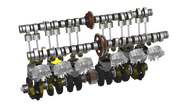How Pistons Work in Automotive Engines
21st Apr 2022

Pistons are an essential component of all combustion-powered automotive engines. Most vehicles have a single piston per engine cylinder. If you drive a four-cylinder vehicle, for instance, it will probably have four pistons. If you drive a six-cylinder vehicle, on the other hand, it will probably have six pistons. Because they are buried within the engine itself, though, you won't see these pistons. What are pistons exactly, and how do they work?
The Basics of Pistons
Pistons are cylindrical-shaped metal components that are designed to convert heat and pressure into mechanical energy. They feature seals known as piston rings, which protect them from the leaking inside of the cylinder. Pistons are also attached to a connecting rod. The connecting rod joins or "connects" the pistons to the crankshaft.
What Are Pistons Made Of?
Different pistons are made of different materials. Some of them are made of stainless steel, whereas other pistons are made of carbon steel. Stainless steel pistons offer greater protection against corrosion, but carbon steel pistons are typically stronger.
You can even find pistons made of aluminum alloys. Aluminum alloy pistons are strong, lightweight and resistant to corrosion. Regardless, all pistons are cylindrical-shaped metal components that convert heat and pressure into mechanical energy.
How Pistons Work
The mechanics of pistons are relatively simple. Combustion-powered automotive engines generate heat and pressure. Upon cranking your vehicle's engine, a mixture of air and gar will begin to burn inside of the combustion chamber. Heat and pressure are byproducts of this process. Pistons work by generating mechanical energy from the heat and pressure inside of the combustion chamber.
Pistons are designed to move and down. During upward strokes, they'll push inside of the combustion chamber. This will trigger combustion in which fuel and air is burned. The burning of this fuel and air will force the pistons back down, thus forcing more fuel and air into the combustion chamber.
Pistons are connected to the crankshaft, which receives the mechanical energy. Pistons will move up and down in response to combustion. As they perform these up and down cycles, they'll turn the crankshaft. Connecting rods join pistons to the crankshaft. Therefore, when pistons move, so will the crankshaft.
The crankshaft's job is to convert linear motion and rotary motion. Without pistons, it won't be able to perform this task. The crankshaft can only turn if the pistons move up and down.



